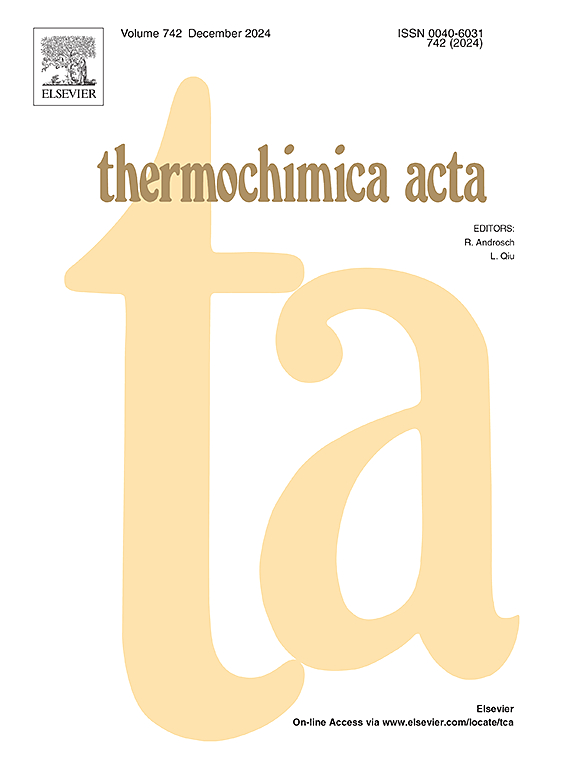Dehydrochlorination of polyvinyl chloride and co-pyrolysis with maize cob: Insight into product composition and thermal behaviour
IF 3.1
2区 化学
Q2 CHEMISTRY, ANALYTICAL
引用次数: 0
Abstract
Polyvinyl chloride (PVC) waste can be a good candidate as feedstock for co-pyrolysis with biomass. However, the high chlorine content in PVC pyrolysis products constitutes a barrier to their use. One way to eliminate chlorine from PVC is dehydrochlorination. This study explores the co-pyrolysis of maize cob with dehydrochlorinated PVC, focusing on product yields, chlorine distribution, and thermal interactions. Virgin PVC was dehydrochlorinated at 593 K, achieving 99 % chlorine removal, and its thermal behaviour was assessed using thermogravimetric analysis (TGA) coupled with Fourier transform infrared spectroscopy (FT-IR). For the three heating rates studied: 5, 10 and 30 K/min, HCl was the main compound released up to 593 K. Lab-scale co-pyrolysis experiments were conducted in a fixed-bed reactor at 873 K with varying biomass-to-PVC mass ratios. Increasing the PVC content enhanced oil yield and aromatic compound formation, slightly increased char carbon content, and redistributed chlorine predominantly into the oil phase. The gas phase was enriched with hydrocarbons such as methane, ethene, and ethane. The results indicate that dehydrochlorinated PVC alters biomass pyrolysis pathways, promoting deoxygenation reactions and reducing char formation. These findings provide insights into optimizing co-pyrolysis conditions for improved product quality, demonstrating the potential of dehydrochlorinated PVC as a carbon-rich additive for thermochemical biomass conversion.

聚氯乙烯脱氢氯化和与玉米芯共热解:洞察产品组成和热行为
聚氯乙烯(PVC)废料可以作为与生物质共热解的良好候选原料。然而,PVC热解产物中氯含量高,对其使用构成了障碍。从PVC中去除氯的一种方法是脱氢氯化。本研究探讨了玉米芯与脱氢氯化PVC的共热解,重点研究了产物收率、氯分布和热相互作用。在593 K下对未加工PVC进行脱氢氯化,氯去除率达到99%,并利用热重分析(TGA)和傅里叶变换红外光谱(FT-IR)对其热行为进行了评估。在5、10和30 K/min三种加热速率下,释放出的主要化合物为HCl,升温至593 K。在873 K的固定床反应器中,以不同的生物质/ pvc质量比进行了实验室规模的共热解实验。聚氯乙烯含量的增加提高了原油收率和芳香族化合物的形成,炭碳含量略有增加,氯主要重新分配到油相中。气相富含碳氢化合物,如甲烷、乙烯和乙烷。结果表明,脱氢氯化PVC改变了生物质热解途径,促进了脱氧反应,减少了炭的形成。这些发现为优化共热解条件以提高产品质量提供了见解,证明了脱氢氯化PVC作为热化学生物质转化的富碳添加剂的潜力。
本文章由计算机程序翻译,如有差异,请以英文原文为准。
求助全文
约1分钟内获得全文
求助全文
来源期刊

Thermochimica Acta
化学-分析化学
CiteScore
6.50
自引率
8.60%
发文量
210
审稿时长
40 days
期刊介绍:
Thermochimica Acta publishes original research contributions covering all aspects of thermoanalytical and calorimetric methods and their application to experimental chemistry, physics, biology and engineering. The journal aims to span the whole range from fundamental research to practical application.
The journal focuses on the research that advances physical and analytical science of thermal phenomena. Therefore, the manuscripts are expected to provide important insights into the thermal phenomena studied or to propose significant improvements of analytical or computational techniques employed in thermal studies. Manuscripts that report the results of routine thermal measurements are not suitable for publication in Thermochimica Acta.
The journal particularly welcomes papers from newly emerging areas as well as from the traditional strength areas:
- New and improved instrumentation and methods
- Thermal properties and behavior of materials
- Kinetics of thermally stimulated processes
 求助内容:
求助内容: 应助结果提醒方式:
应助结果提醒方式:


